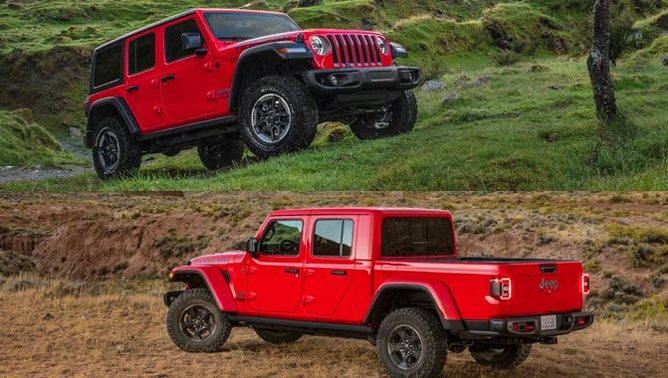Fans of the seven-slot grille have had a lot to be excited about over the past year.
Not only have they been basking in the introduction of a new Wrangler, but product planners at Jeep have also #blessed them with the brand’s first pickup truck in ages. With the Gladiator now appearing in showrooms, we thought it a great time to stack these two siblings against each other.
Similarities exist, of course, but there are far more differences than meets the casual eye. Dyed-in-the-wool Jeepheads will be able to tell some of this stuff at a glance but the rest os uf may need to look a bit deeper. Fortunately, that’s where we come in.
Jeep Wrangler vs Gladiator
Powertrains
Wrangler: Behind that recognizable grille is a recognizable engine. The volume mill in Wrangler is the they-put-that-in-everything Pentastar 3.6L V6, making 285 horsepower in this application. Torque checks in at 260 lb-ft, more than enough to turn those big meats through an off-road course. At present, there is also a turbocharged four-cylinder engine with a mild hybrid setup, making 15 fewer horses but 35 more units of twist. Note: the smaller displacement mill enjoys swilling 91 octane fuel. Drivers of the V6 can select an eight-speed auto or six-speed manual while the four-banger is automatic only.
ALSO SEE: Why the Four-Cylinder Hybrid is the Best Powertrain in the Jeep Wrangler
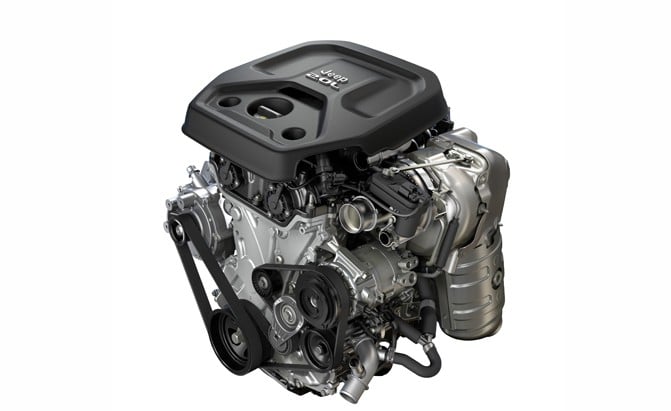
Gladiator: Citing gearing and “personality” concerns, Gladiator is available only with the ubiquitous V6, making identical power numbers as it does in its non-pickup truck brother. Standard with this engine is a six-speed manual but buyers can also choose to get the Pentastar with an eight-speed automatic. The transmission gearing is identical between the two Jeeps, in case you’re wondering.
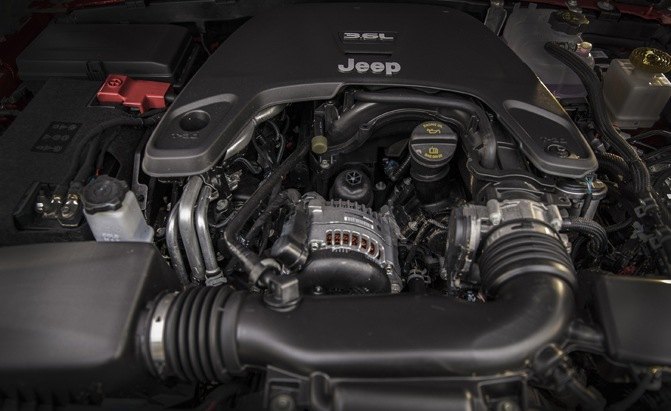
Bottom Line: Wrangler has double the number of engine choices, so those seeking to exercise their right to choose might enjoy sampling that machine. Pro tip: if you’re getting the V6, stick with the manual transmission. This is one rig whose resale value probably won’t suffer because of it.
ALSO SEE: 2020 Jeep Gladiator Review – Video
Off-Road Prowess
Wrangler: Moving from entry-level Sport to high-zoot Rubicon, there are three different transfer case systems available in Wrangler. Command-Trac and Rock-Trac are part-time units, offering up high and low ranges as one would expect. The latter t-case has a low range ratio of 4.0:1, hence the reference to rock crawling in its name. A final drive ratio of 4.10 on the Rubicon is appropriately aggro for this model. The third transfer case type, called Selec-Trac, is a full-time unit, optionally available on the Sahara and arguably aimed at people who are not as familiar with off-roading as the average Jeep owner. Think of it as an option for folks who will be pressing the Sahara into daily drive duties.
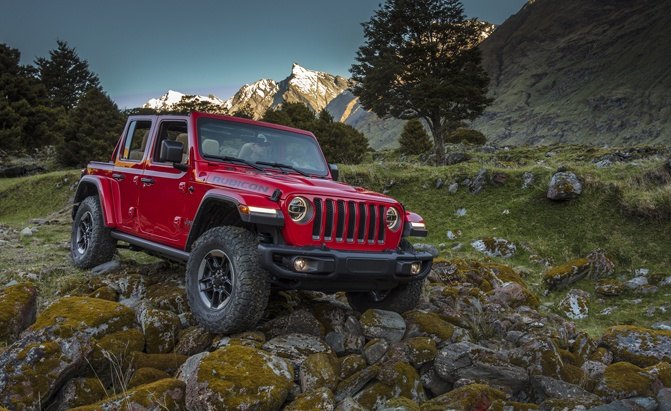
Gladiator: Selec-Trac vanishes on the Gladiator, leaving just the pair of part-time units. In terms of axles, 3rd-gen Dana heavy duty logs show up front and rear, along with a Tru-Lock rear locker on Rubicon models which also get High-pressure gas-charged Fox aluminum monotube shocks. Sport and Overland trims lose the Fox designation on their shocks but retain so-called multi-tube valve technology.
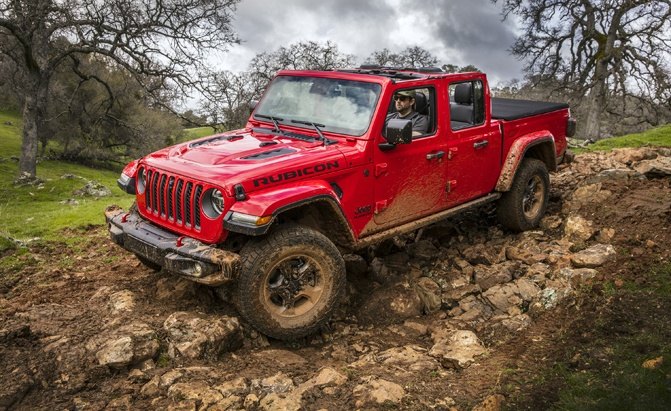
Bottom Line: As with its powertrain, the Wrangler offers more options. Neither rig is likely to leave their driver stranded under reasonable conditions. If it’s your first time buying a “real” Jeep, and you plan to use the thing as a family hauler, consider the easy-to-use Selec-Trac system found in Sahara models.
Clearance and Angles
Wrangler: As with most things in life, Wrangler customers you get what they pay for, especially in terms of clearances and angles. Standard on Sport models are 245/75/R17 tires, affording a total of 9.7 inches of ground clearance and an approach angle of 41.4 degrees. Bumping up to the Sahara shod with 18s raises those measures to 10 inches and 41.8 degrees respectively, while the Rubicon goes on to a clearance of 10.8 inches and an extra couple of degrees on the angle of attack. Be mindful if you choose a 4-door Unlimited, as breakover angles suffer by about five degrees on all models, dropping from 27.8 to 22.6 on the Rubicon, for example. A departure angle of about 36 degrees is standard across the board.
ALSO SEE: 10 Best Off-Road Tires and How to Pick the Right Ones
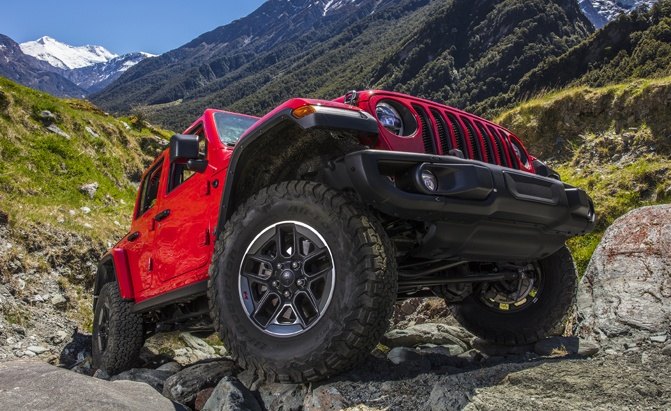
Gladiator: By now, most gearheads know the Glad is a lot more than simply a Wrangler that’s been gifted a truck bed. This is borne out by these types of off-road measures. Sport and Overland trims enjoy approach and breakover angles of 40.8 and 18.4 degrees respectively, while ground clearance is measured at an even 10 inches. Stepping to a Rubicon grants a 43.4-degree angle of attack and a 20.3-degree breakover. All Gladiators have a departure angle of about 25 degrees.

Bottom Line: Thanks to longer overhangs, especially at the rear, the Gladiator gives up much in terms of outright off-road measures compared to the Wrangler. This is doubly true when comparing it to a 2-door Wrangler. It’s hard to fit a pair of dirt bikes in the back of a two-door Wrangler, though, so consider your priorities carefully.
ALSO SEE: Top 10 Best Jeep Wrangler Accessories
Towing
Wrangler: Regardless of engine option, transmission choice, or axle spec, the 2019 Wrangler taps out at 3,500 lbs in terms of towing capacity. This speaks more to the capability of the chassis than anything, as the same powertrain can haul a lot more weight in other FCA vehicles.
Gladiator: Properly kitted, Jeep’s pickup can haul a not-insignificant 7,650 lbs, a number that plays with the best midsizers and even a few half tons. Spec carefully if heavy towing is on your list of Gladiator activities, as lightweight versions equipped with 3.73 gears and a manual transmission can max out at just 4,000 lbs. Slushbox Glads fitted with that same rear end spec are only 4,500 lbs. At minimum, go for the 4.10s if you plan on doing a lot of heavy hauling.
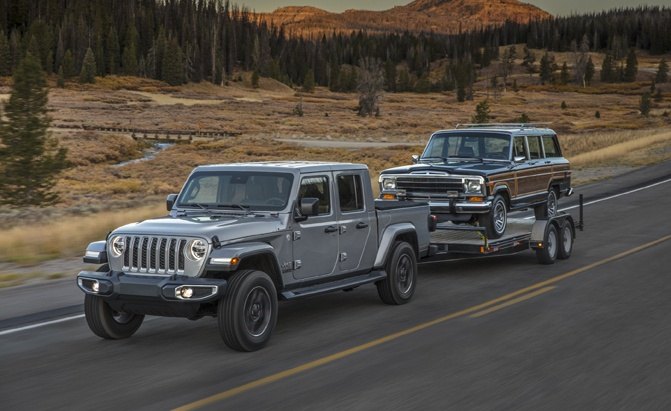
Bottom Line: Gladiator wins this one, hands down.
Technology
Wrangler: In the not-too-distant past, Wranglers were considered agricultural at best, often lavishly equipped as a Romanian prison. Today, air conditioning is standard across the board while snappy LEDs illuminate in ways that knackered old incandescents could never imagine. On snazzy trims, FCA’s excellent 8.4-inch Uconnect touchscreen is standard kit, as are items like rear parking assists, a reverse camera, and blind spot monitoring. The days of prehistoric ventilation controls in the CJ are long gone.
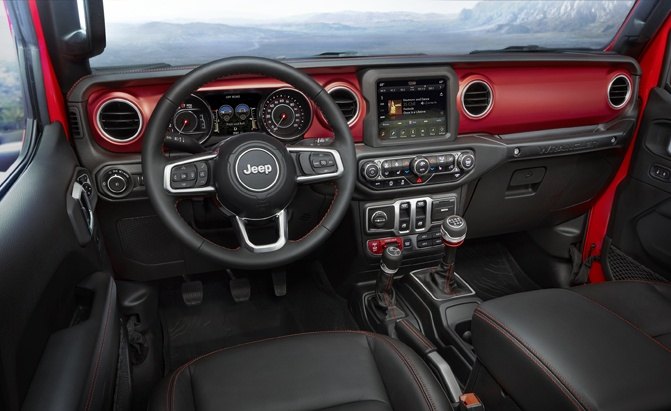
Gladiator: Most of what’s available in the Wrangler shows up in the Gladiator, as Jeep made the sensible decision to share many interior parts between the new models. Without that move, we likely wouldn’t have a Gladiator at all. Air conditioning is standard on every model, a raft of USB ports are available, and the level of infotainment matches the Wrangler. The Gladiator does have an additional front-facing camera, which could come in handy while off-roading, and a removable Bluetooth speaker.
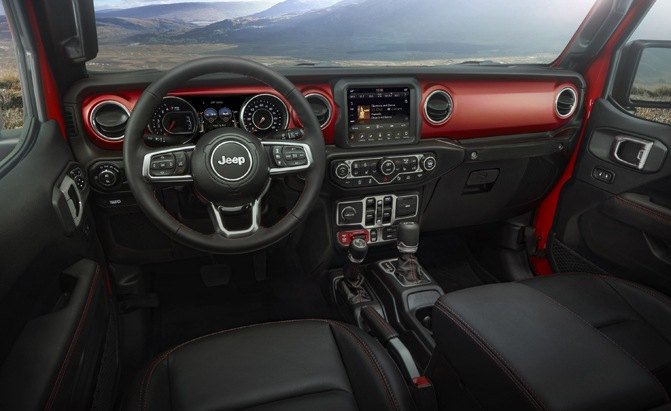
Bottom Line: Since it is a slightly newer model, the Gladiator enjoys a small advantage in terms of some minor technology kit, features that will likely make it into the next Wrangler update. For now, however, we’re giving the win to Gladiator and its neato removable Bluetooth speaker (hey, we like tailgating).
Cabin Space
Wrangler: It goes without saying that 2-door Wranglers are decidedly short on rear seat space compared to its Wrangler Unlimited and Gladiator brothers. Front leg- and headroom checks in at 41.2 inches and 42.8 inches, respectively, but note that a hardtop shaves two inches off the latter measure. Rearseat legroom is advertised at 38.3 inches for the Unlimited, just 2.5 inches more than the smaller Wrangler. The big difference is in hiproom: 45 inches in 2-door model, 56.7 inches in the 4-door rig.
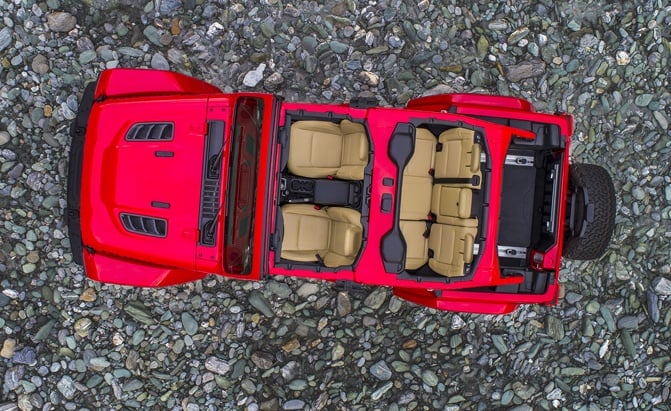
Gladiator: Front head- and legroom is identical to that of the Wrangler, though the Gladiator has about 1.5 inches more seat travel. Since this model is only available as a four-door unit, back seat riders will enjoy the same amount of space as in the Wrangler Unlimited, albeit with a smidge less hip room for reasons best left unexplained.
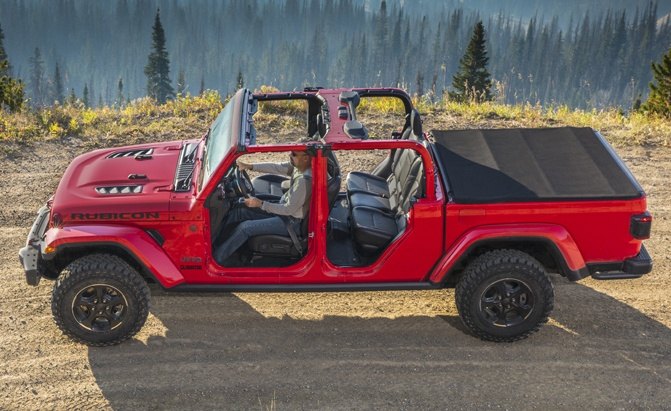
Bottom Line: Any family thinking of buying a Wrangler for road trip duties are well advised to pass on the 2-door Wrangler; do not pass go, do not collect $200. Beyond that model, however, the Wrangler Unlimited and Gladiator are very similar in terms of cabin space, both front and rear. Is the Glad worth it for the open bed and undeniable cool factor? Only you can answer that one.
Cargo Capacity
Wrangler: The extra length grafted onto a Wrangler to create a four-door Unlimited seems to allocate all its newfound space to rear seat passengers. The nerve. All Wranglers are listed as having 31.7 cubic feet of cargo volume with the rear seat upright, 72.4 cubes with the rear seat folded. Its liftover height of nearly 30 inches is not to be underestimated when trying to heave heavy objects into the cargo area.
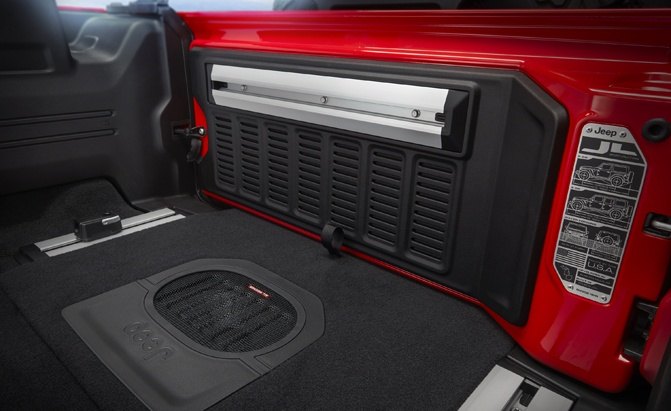
Gladiator: Box volume works out to a total of 35.5 cubic feet, or an all-too-even 1.0 cubic meter, which sounds a lot less impressive. With the tailgate shut, the box length measures 60.3 inches, about the same as other short box midsize trucks on the market. Drop that ‘gate to reveal 81.3 inches of bed length, though one will definitely need to properly secure their cargo before setting out with the tailgate lowered.
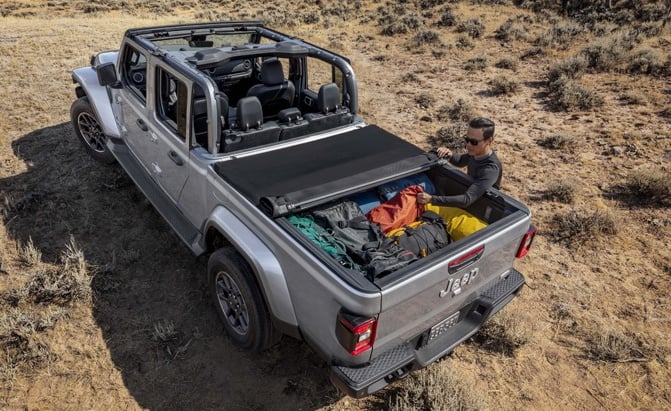
Bottom Line: For cargo hauling duties, the Gladiator is a much better selection. With an open bed, owners can freely take their favorite tree or grandfather clock with them on the next road trip. For locked and dry space, however, it’s hard to beat the safe-and-sound interior of the Wrangler (assuming you’ve installed the top and doors, of course).
Fuel Economy
Wrangler: Stickshift versions of a V6 Wrangler are rated at 17/23/19 mpg on the EPA city/highway/combined testing cycles. Selecting the eight-speed automatic transmission improves those numbers to 18/23/20mpg. Those who decide to choose a turbocharged Wrangler, available only with an automatic, will find themselves in possession of a machine with EPA ratings of 23/25/24 mpg. Weirdly, and perhaps speaking to the harder time this turbo has hauling around extra weight, four-door models earn just 22/24/22 mpg ratings. A fuel tank capacity of 18.5 gallons or 21.5 gallons grace the 2- and 4-door Wranglers, respectively. Keep in mind that the turbo four likes to swill the expensive stuff.
Gladiator: A 22-gallon tank shows up in every Gladiator. Official EPA ratings aren’t yet available as of this writing but expect them to come in just slightly south of a V6-equipped Wrangler thanks to extra weight.
Bottom Line: Using outright numbers, a two-door Turbocharged Wrangler bests all others in this part of the comparison, cresting 25 mpg according to the EPA.
Style
Wrangler: Stylists at Jeep did a great job massaging the Wrangler’s recognizable face when it was designing this JL-era machine. With its just-right round peepers framing a seven-slot grille, the 2019 model can’t be mistaken for anything other than a Jeep. The Rubicon looks decidedly rugged, with knobby tires and a high stance. Two-door versions retain the classic Jeep profile and, while the four-door Unlimited looks like Jeep that got caught in a taffy puller, it also looks the business.
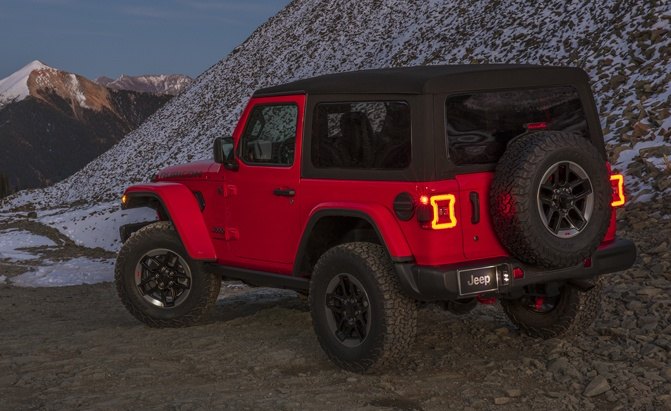
Gladiator: Speaking of the business, contractors and tradespeople worldwide can now jump into the Jeep lifestyle, thanks to the Gladiator’s open bed, a space measuring five feet in length. Some say that the extra length spoils the Jeep aesthetic but those same people presumably kick kittens and weren’t loved as children. With a practical bed (it even has hashed indentations with which to line up the wheels of a dirt bike, the new Gladiator has style for days. Weeks, even.
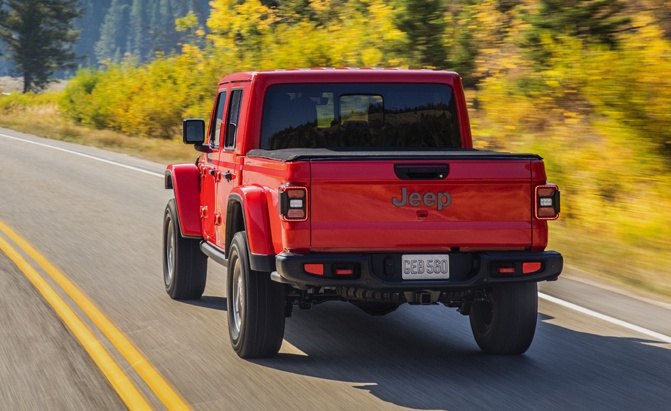
Bottom Line: Your author prefers the Gladiator, hands down. Since I’m the one writing this post, it gets a mark towards it in the win column.
Pricing
Wrangler: Base models, called the Sport, start at $28,045 for a 2-door model. Upgrading to a 4-door will hoover an extra $3500 from your wallet. Note that the rock-ready Rubicon, at $41,545 for a quad-door, is no longer the top dog. A new Sahara Altitude model is priced a few Simoleons higher. Top honors now go to the Moab model with its 32-inch mud terrain tires, priced at a mystifying $51,300.
The Verdict: Jeep Wrangler vs Gladiator
It’s difficult to fault any Wrangler or Gladiator, at least when it comes to cool factor and pegging the grin meter. The new pickup truck is definitely more expensive but it just oozes personality, especially in Rubicon flavor. As a left-field alternative to an SUV or another midsize truck, it is a dandy option.
Those seeking to get their Jeepy thrills on the trail will forever be best served to buy a two-door Wrangler. With the best mix of off-road measurements and price, it’s tough to beat the thing for out-of-the box capability. In fact, it’s tough to believe that such a go-anywhere machine is available right off the showroom floor with a warranty.
From AutoGuide.com
